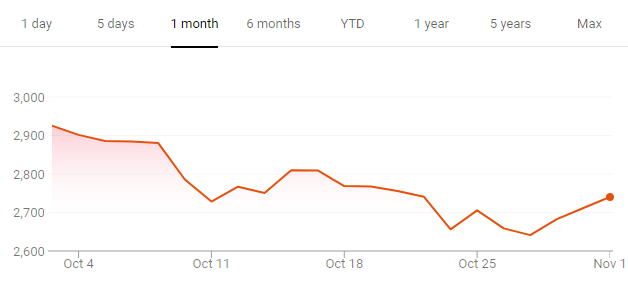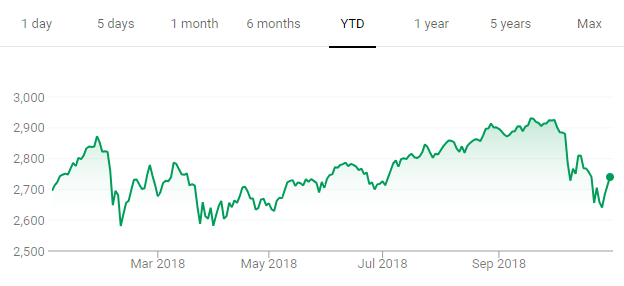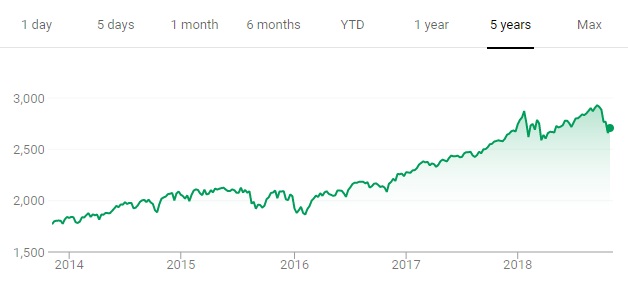Market Corrections & Investing Strategy
After a rocky October for investors, I want to share some thoughts on the current state of the markets and the immense value of a long-term investing plan.
* * *
The news for investors was pretty dire last month. Here are a few of the words and phrases you may have seen in the headlines:
- Wiped out
- Tumbled
- Erased
- Slumped
- Worst
Not really the words you want to see when you’re reading the Business & Finance page of The Wall Street Journal.All the major stock indices either entered or approached correction territory. A market correction is loosely defined as a 10% (or greater) drop from a recent high.The NASDAQ officially saw a correction, while the Dow Jones Industrial Average and S&P 500 each dropped 8-9% from recent peaks and briefly went negative for 2018.Let’s take a quick look at some charts of the S&P 500 over the last month, year, and five-year periods for a refresher on where we are and where we’ve been.Here we are for October 2018. Not good, but at least we had a little rebound towards the end of the month. The next chart is 2018 to-date. A little better than the last one – the data line is green, indicating that the S&P closed on November 1 higher than it started in January. But we can see just how hard October hit the index, wiping out most of the gains that had been made since the beginning of the year.
The next chart is 2018 to-date. A little better than the last one – the data line is green, indicating that the S&P closed on November 1 higher than it started in January. But we can see just how hard October hit the index, wiping out most of the gains that had been made since the beginning of the year. The five-year chart below probably makes us all feel a lot better, but it’s clear that the October 2018 correction was as big of a short-term drop as the S&P has seen in the last five years.
The five-year chart below probably makes us all feel a lot better, but it’s clear that the October 2018 correction was as big of a short-term drop as the S&P has seen in the last five years. October was certainly bad news for short-term traders looking to make a quick buck. But if you are an individual investor planning for the long run -- and remember that, even if you’re already retired, retirement is long -- then the recent losses don’t necessarily mean you need to change your plan.Of course, that assumes that you have a plan.There is nothing quite like a market correction to illustrate the value of a long-term investing plan.Long-term goals help you see the big picture without getting too caught up in the moment. Additionally, the process of drafting a long-term investing strategy should help you learn about and internalize investing basics like diversification, rate of return, and the fact that market volatility is normal.When you’re familiar with these aspects of investing, it makes it much easier to remember that when the markets drop, the best course of action is often the simplest one of all -- just ride it out.
October was certainly bad news for short-term traders looking to make a quick buck. But if you are an individual investor planning for the long run -- and remember that, even if you’re already retired, retirement is long -- then the recent losses don’t necessarily mean you need to change your plan.Of course, that assumes that you have a plan.There is nothing quite like a market correction to illustrate the value of a long-term investing plan.Long-term goals help you see the big picture without getting too caught up in the moment. Additionally, the process of drafting a long-term investing strategy should help you learn about and internalize investing basics like diversification, rate of return, and the fact that market volatility is normal.When you’re familiar with these aspects of investing, it makes it much easier to remember that when the markets drop, the best course of action is often the simplest one of all -- just ride it out.
